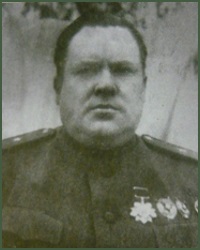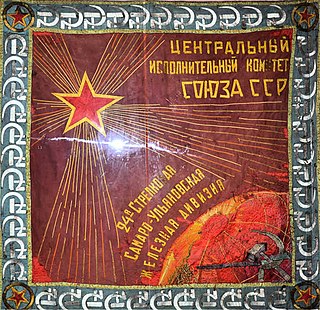
The Western Group of Forces (WGF), previously known as the Group of Soviet Occupation Forces in Germany (GSOFG) and the Group of Soviet Forces in Germany (GSFG), were the troops of the Soviet Army in East Germany. The Group of Soviet Occupation Forces in Germany was formed after the end of World War II in Europe from units of the 1st and 2nd Belorussian Fronts. The group helped suppress the East German uprising of 1953. After the end of occupation functions in 1954 the group was renamed the Group of Soviet Forces in Germany. The group represented Soviet interests in East Germany during the Cold War. Before changes in Soviet foreign policy during the early 1990s, the group shifted to a more offensive role and in 1989 became the Western Group of Forces. Russian forces remained in the eastern part of Germany after the dissolution of the Soviet Union and German reunification until 1994.
The 3rd Army was a field army of the Red Army during World War II.

The 3rd Ukrainian Front was a Front of the Soviet Red Army during World War II.

The Vienna offensive was an offensive launched by the Soviet 2nd and 3rd Ukrainian Fronts in order to capture Vienna, Austria, during World War II. The offensive lasted from 16 March to 15 April 1945. After several days of street-to-street fighting, the Soviet troops captured the city.
The 45th Rifle Division was a Red Army infantry division formed originally during the Russian Civil War that fought in World War II and then served through the Cold War in the Leningrad Military District.
A rifle corps was a Soviet corps-level military formation during the mid-twentieth century. Rifle corps were made up of a varying number of rifle divisions, although the allocation of three rifle divisions to a rifle corps was common during the latter part of World War II.
The 7th Rifle Division was an infantry division of the Soviet Union's Red Army, formed twice.

The Baltic strategic defensive operation encompassed the operations of the Red Army from 22 June to 9 July 1941 conducted over the territories of the occupied Lithuania, Latvia, and Estonia in response to the offensive launched by the Wehrmacht in Operation Barbarossa.

The 90th Guards Rifle Vitebsk Division was an infantry division of the Red Army during World War II. Formed from the 325th Rifle Division in recognition of its actions during the winter of 1943, the division fought in the Battle of Kursk, the Belgorod-Khar'kov Offensive Operation, Operation Bagration, the Baltic Offensive, the Vistula–Oder Offensive, and the East Prussian Offensive.
The 8th Rifle Division was a military formation of the Soviet Union's Red Army in the Winter War, the Soviet invasion of Poland, and World War II. It was formed three times.
The 13th Guards Army Corps was a corps of the Soviet Ground Forces, formed from the previous 13th Guards Rifle Corps, which saw service during the Second World War.

The 306th Rifle Division began its combat path under unusual circumstances. It was partly formed for the first time as a standard Red Army rifle division a few months after the German invasion, but the formation process appears to have been abandoned and the unit was never assigned to the front. A second formation began in April 1942 and was completed on June 16, after which it was sent to the Kalinin Front. Assigned to 43rd Army, it remained in that Army until November 1944, and in that Front until March 1945. It ended the war in Leningrad Front, helping to contain the German forces trapped in the Courland Pocket. The division had compiled a solid record of service and won a unique battle honor by this time, and was disbanded shortly after hostilities ended.

The 310th Rifle Division was a standard Red Army rifle division formed on July 15, 1941 in Kazakhstan before being sent to the vicinity of Leningrad, where it spent most of the war, sharing a similar combat path with its "sister", the 311th Rifle Division. The soldiers of the division fought until early 1944 to, first, hold open some sort of lifeline to the besieged city, then to break the siege and drive off the besieging German forces. They then participated in the offensive that drove Germany's Finnish allies out of the war. Finally, the division was redeployed to take the fight to the German heartland in the winter and spring of 1945. It ended the war north of Berlin with a very creditable combat record for any rifle division.
The 81st Guards Rifle Division is an infantry division of the Russian Ground Forces, previously serving in the Red Army and the Soviet Army. It was formed after the Battle of Stalingrad from the 422nd Rifle Division in recognition of that division's actions during the battle, specifically the encirclement and the siege of the German forces in the city. The 81st Guards continued a record of distinguished service through the rest of the Great Patriotic War, and continued to serve postwar, as a rifle division and later a motor rifle division, until being reorganized as the 57th Separate Guards Motorized Rifle Brigade in 2009 in the Russian Ground Forces. Most of its postwar service was in the Soviet (Russian) far east, where it was originally formed as the 422nd.
The 64th Guards Rifle Division was created on January 19, 1943, from the 327th Rifle Division, in recognition of that division's distinguished combat record in the Second Siniavino Offensive and Operation Iskra. It was one of a relatively small number of formations raised to Guards status in the northern sector of the Soviet-German Front. As such, it was employed as an assault division in the subsequent fighting, particularly in the final defeat of the German forces before Leningrad, and the final offensive against Finland. The division ended the war in Lithuania, helping to contain the enemy forces trapped in the Courland Pocket, and went on to serve well into the postwar era, still in the Leningrad/St. Petersburg area.
The 297th Rifle Division was an infantry division of the Soviet Union's Red Army during World War II, formed twice. Its first formation was formed in the summer of 1941 and destroyed during Case Blue, the German summer offensive towards Stalingrad, in 1942. Reformed in the summer of 1943, the division's second formation fought in combat for the rest of the war before being disbanded postwar.
The 56th Rifle Division was an infantry division of the Red Army and later the Soviet Army of the Soviet Union, formed three times.
The 265th Motor Rifle Division was a motorized infantry division of the Soviet Army during the Cold War.

The 68th Mountain Rifle Division was a mountain infantry division of the Red Army before and during World War II.
The 417th Rifle Division was formed as an infantry division of the Red Army in the spring of 1942 and served in that role until after the end of the Great Patriotic War. Although it was formed in the Transcaucasus, unlike the 414th and 416th Rifle Divisions formed in about the same place at the same time it was never designated as a National division. After its formation it remained in service in the Caucasus under direct command of the Transcaucasus Front until the summer of 1942, when it was redeployed first to the Northern Group of Forces in that Front and then to the 9th Army. As German Army Group A retreated from the Caucasus in January, 1943 the division was reassigned to the 58th Army and a few months later to 37th Army in North Caucasus Front. In July it redeployed northward to join Southern Front, where it was assigned to the 63rd Rifle Corps in 44th Army in mid-September as the Front fought through south Ukraine, eventually reaching the land routes to the Crimea. It took part in the offensive that liberated that region in April and May, 1944, fighting in the 51st Army and winning both a battle honor and the Order of the Red Banner in the process. After the Crimea was cleared the 51st Army was moved far to the north, joining 1st Baltic Front. During operations in the Baltic states the 417th was further distinguished with the award of the Order of Suvorov. In March, 1945 it joined the Courland Group of Forces on the Baltic coast containing the German forces encircled in northwest Latvia. It ended the war there and was soon moved to the Ural Military District before being downsized to a rifle brigade. This brigade was briefly brought back to divisional strength during the Cold War.







